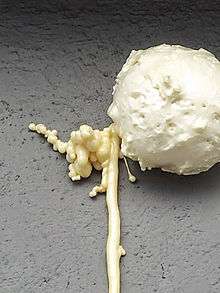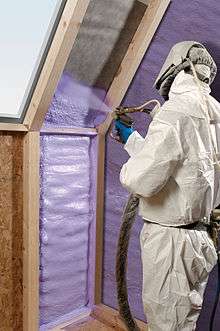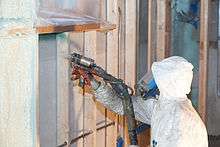Spray foam

Spray foam is a chemical product created by two materials, isocyanate and polyol resin, which react when mixed with each other and expand up to 30-60 times its liquid volume after it is sprayed in place. This expansion makes it useful as a specialty packing material which forms to the shape of the product being packaged and produces a high thermal insulating value with virtually no air infiltration.
History
Otto Bayer (1902-1982) is credited with the invention of polyurethane in 1937. He succeeded in synthesizing polyurethane foam by exploring his basic idea that mixing small volumes of chemical substances could create dry foam materials.[1]
Polyurethane was further developed for different applications, ranging from shoe soles and cushions to industrial uses. In the 1940s rigid foam was applied to airplanes,[2] and in 1979 polyurethane began being used as building insulation.[3]
Properties
Thermal resistance
R-value is the term given to thermal resistance to heat flow. The higher the R-value of an insulation product, the more effective the insulation properties. 1.8-2 pound polyurethane foam has the highest R-value of readily available insulation used in homes and buildings.[4]
Polyurethane is a closed-cell foam insulation material that contains a low-conductivity gas in its cells.[5] As a result of the high thermal resistance of the gas, spray polyurethane insulation typically has an R-value around R-5 to R-6 per inch.[5] In comparison, blown fiberglass typically has an R-Value of only R-2 to R-4 per inch.[6]
Foam insulation blocks all three forms of heat transfer:
- Conductive heat transfer
- The flow of thermal energy through a substance from a higher to a lower temperature region. Foam thermoset plastics block conductive heat transfer due in part to having very loose molecular bonds; In addition the cells of the installed spray foam are either filled with air in the case of open cell foam or 245fa in closed cell foam.
- Radiant heat transfer
- The process by which heat energy in the form of light (usually IR unless the substrate is hot enough to glow in the visible range) is emitted more strongly by warm surfaces and absorbed by other materials especially those of low IR reflectivity (think matte black finish). Radiant heat transfer does not require a medium. Thermoset foams, such as spray foam insulation, have the ability to reflect radiant heat. This is due to the reflective (shiny, in terms of IR) surfaces within the cell structure of the foam.
- Convective heat transfer
- Heat which is created elsewhere that is transported by means of a fluid, such as water or in our case air. Spray foam insulation's most important attribute is the ability to air seal creating a custom airtight envelope within the building structure. The added benefit to air sealing is the ability to block convective heat transfer from interior to exterior during heating months and vice versa during cooling months, as the heat cannot escape through gaps in the buildings envelope without the aid of air movement from infiltration as a means of transport.
Applications
Packaging applications
Spray foam is a very specialized packing material, often required for use in shipping valuable fragile items. Engineered packaging principles are designed to protect sculptures, vases, large fossils, lamp bases, busts, computers, furniture, chandeliers and other objects of unusual shape. By virtue of the liquid foam expanding by up to 30-60 times the volume of its liquid state, it efficiently protects almost any size, form and weight.
The custom fit of the molds, top and bottom, securely and uniformly cushions the object. There are many types of alternative materials that can be used to handle more specific needs.
Building applications


Spray foam insulation or spray polyurethane foam (SPF) is an alternative to traditional building insulation such as fiberglass. A two-component mixture composed of isocyanate and polyol resin comes together at the tip of a gun, and forms an expanding foam that is sprayed onto roof tiles, concrete slabs, into wall cavities, or through holes drilled in into a cavity of a finished wall.
"Spray foam" is also an informal term used to refer to various plastic foam materials that are used in building construction to provide thermal insulation and minimize air infiltration. Polyurethane and polyisocyanurate are two types of foam used in this application.
Types
Spray polyurethane foam (SPF) insulation can be categorized into two different types: light-density open-cell spray foam insulation and medium-density closed-cell spray foam insulation. Both types of SPF are thermoset cellular plastics comprising millions of small cells.[7]

Open cell insulation can be crushed in your hand and has a lower insulation value. Closed cell, is rigid to the touch and each air cell is completely sealed. While closed cell foam has a higher R-value it is more costly to buy.[8]
Medium-Density Closed-Cell Spray Foam (ccSPF)
Medium-density closed-cell foam insulation is often referred to as two pound (2 lb) foam. It is a rigid insulating material with an Long Term Thermal Resistance (LTTR) R-value that ranges between 5.1 - 6 per inch[9] When the required minimum thickness of 50 mm is installed, ccSPF is both a vapour barrier and an air barrier.
In Canada, the National Building Code references two standards that apply to the manufacturing and installation of ccSPF: the CAN/ULC S705.1 Material Standard and the CAN/ULC S705.2 National Application Standard. The installation standard requires that all installers of ccSPF in Canada be licensed and carry a photo ID card.[10]
Typically the foam's natural colour is yellow, however in Canada all ccSPF that have CCMC listings are required to have a unique colour for field identification.[11]
Light-Density Open-Cell Spray Foam (ocSPF)
Light-density open-cell SPF is commonly known as half-pound foam. It is a semi-rigid material with a sponge-like appearance that expands during installation and creates small, open cells that are filled with carbon dioxide. Due to its ability to expand during the application process, it fills cracks, crevices and voids and adheres to irregular surfaces or substrates to form an air sealing insulation.[12]
While the R value will vary, most ocSPF products have an R value of around 3.8 per inch. Unlike medium-density closed-cell SPF, ocSPF is not a vapour barrier. When installed at 5.5 inches or more, ocSPF does act as an air barrier. It is often used for interior walls because it provides sound reduction by blocking and absorbing air leakage. It is usually only recommended for indoor applications.
Application methods
Asia
A type of use quite familiar in South East Asian countries is applying the pu or pur foam by spraying it against the bottom of roof tiles under high pressure with a spray gun. A hard but flexible layer of rigid foam is then created and seals all the tiles to each other and to the steel structure.
This spraying method, especially very popular in Thailand, is used not only against heavy leaks but helps also as insulation against the enormous heat the roofs constantly face.
This tropic heat actually is the cause that the steel structure, which most roofs in that part of the world are built on, expands and contracts all the time. By doing so, the sun-battered steel structure causes the roof tiles to dislodge and slowly creates small openings between the roof tiles, through which rain water can run into, creating leaks that can cause much damage to plastered ceilings and electric wiring.
Polyurethane Foam provides a complete, seamless building envelope, creating a more comfortable indoor environment for the life of your home.
To avoid the expense re-roofing a house that is simply suffering from nail fatigue, and to obtain optimum insulation, an 85mm layer of polyurethane foam can be sprayed onto the underside of the slates or tiles of a pitched roof. This stabilises and weatherproofs the roof by fixing the nails, battens and roofing felt. As the foam is a superior insulant, coupled with just 100mm of insulation at joist level, your roof will also meet the stringent thermal performance standards required for a new home. A typical roof can be insulated using the polyurethane treatment for around half the cost of re-roofing.
The insulation at eaves level will leave your loft area comfortable for use and free from condensation. By installing the insulation at rafter level, it keeps the loft void warmer and prevents condensation build-up, which can otherwise occur when increasing insulation at ceiling level. The warmer, drier, cleaner roof space eliminates the risk of pipes and tanks freezing.
Europe
Some 150,000 properties have been treated with polyurethane foam insulation in the UK. There are systems which have British Board of Agreement approval for use in existing and new build applications and can show compliance to Building Regulations.
North America
The Canadian National Building Code references the CAN/ULC S705.2 National Application Standard which must be followed during all installations of 2lb medium density closed cell polyurethane foam. Every installer must be licensed in order to spray foam and hold valid photo ID issued by their Quality Assurance Program (QAP) provider showing their license is in good standing.[13] The largest QAP provider for spray foam installers and contractors in Canada is a non-profit organization called CUFCA.[14]
The United States has adapted to using sprayfoam insulation and a new technology called Wall Injection to retrofit existing wall construction by drilling small holes between wall studs in the structures framing and filling the void with a less aggressive expanding water based foam. This allows existing home and business owners to conserve energy by creating a thermal envelope in their existing structure.
Benefits
Spray foam insulation saves on energy costs and lowers utility bills. Studies by the US Department of Energy show that 40% of a home's energy is lost as the result of air infiltration through walls, windows and doorways. Buildings treated with spray foam insulation insulate as much as 50% better than traditional insulation products.
Insulation that is sprayed in buildings protects against moisture, which provides the benefit of reducing the chance of harmful mold and mildew. Eliminating mold growth reduces the likelihood of rotting wood in a home, and allergic reactions to mold spores.
In addition to building temperature and moisture control, spray foam insulation is often used to reduce noise. Foam insulation serves as a barrier to airborne sounds, and reduces airborne sound transfer through a building's roof, floor and walls.
In the United States, homes treated with spray foam insulation often qualify for state and federal tax deductions.[15]
Insulation of all types stops a good deal of energy loss. Some types including spray foams also seal air leaks. Insulation can also save energy in hot climates by reducing air conditioning use.
Health effects
Spray foam insulation is typically non-toxic only after it has cured. While curing spray foam emits a gas that causes blurred vision and trouble breathing. Using full face and respiratory protection while applying the product is recommended.[16]
Isocyanates are powerful irritants to the eyes and gastrointestinal as well as the respiratory tracts. Direct skin contact with isocyanates can also cause marked inflammation. Some people say that their eyes feel like they have sand in them at the onset of problems. Some break out in a rash on their arms, chest, and neck.
Overexposure to isocyanates can sensitize workers, making them subject to asthma attacks if they are exposed again. Respiratory irritation may progress to a chemical bronchitis. Additional exposures can make the onset easier with less isocyanate necessary to start the attack.
Sporadic cases of hypersensitivity pneumonitis (HP) have also been reported in workers exposed to isocyanates. The symptoms may seem like the flu, with fever, muscle aches, and headaches. Other symptoms may include a dry cough, chest tightness, and difficult breathing. Individuals with chronic HP often experience progressively more difficult breathing, fatigue, and weight loss. Individuals with acute HP typically develop symptoms 4-6 hours after exposure.[17][4]
See also
References
- ↑ AG, Bayer. "Otto Bayer – Important Personalities of Bayer's History". www.bayer.com. Retrieved 2016-08-03.
- ↑ Seymour, Raymond B.; Kauffman, George B. (1992). "Polyurethanes: A Class of Modern Versatile Materials". J. Chem. Ed. 69: 909. doi:10.1021/ed069p909.
- ↑ "Polyurethanes in Polyurethanes timeline". www.polyurethanes.org. Retrieved 2016-08-03.
- 1 2 Insulation Alternatives: Sprayed Foam Insulation
- 1 2 Polyurethane Insulation Materials
- ↑ Insulation Values For Selected Materials
- ↑ Spray Applied Rigid Polyurethane Insulation Installer Training Program Manual. CUFCA. 1 October 2014. p. 5.
- ↑ "Closed-cell spray foam tops home insulation options". Montreal Gazette. Retrieved 29 January 2013.
- ↑ "Technical Documents | CUFCA". www.cufca.ca. Retrieved 2016-08-03.
- ↑ "What Foam Do I Ask For? / How Do I Know If I Received What I Asked For? | CUFCA". cufca.ca. Retrieved 2016-08-03.
- ↑ "CMC Registry of Construction Product Evaluations". National Research Council Canada. Retrieved 3 August 2016.
- ↑ Low Density Semi-Rigid Open Cell Training Manual. Canada: CUFCA. 2014. p. 3.
- ↑ "What Foam Do I Ask For? / How Do I Know If I Received What I Asked For?". CUFCA: How To. Retrieved 3 August 2016.
- ↑ "CUFCA". CUFCA. Retrieved 3 August 2016.
- ↑ Federal Tax Credits for Consumer Energy Efficiency
- ↑ Spray Foam Insulation: Installation, Tips and Best Practices
- ↑ Foam Insulation vs Standard Insulations